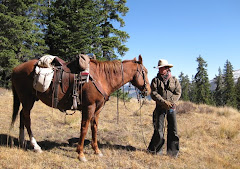 What do you call it? I call it an extreme sport.
What do you call it? I call it an extreme sport.No, it’s not rock climbing or sky diving or heli-skiing. But horse packing in the back country is nothing less than… extreme. Think of what you’re up against: unpredictable elements and untamed nature, trails unmanaged and/or unknown, solitude and/or stuck working with some less than ideal companions, managing horses who may have their own mind and agenda, the wilds and the wilderness, within us as well as about us. At best, you return cold and sore. You give up comforts for... for... for what, you might ask?
For a sunrise over the magnificent mountains while sipping hot coffee and watching contented horses graze. Meals which taste so much better cooked over the open fire. A view you become a part of, something no photos could possibly capture. A bonding with our horses which does not come from a little ride in the arena. Lying snuggled in a tent between my family, there together safe and warm, hearing the gentle snorting of the nearby horses. I am wanting for nothing more.
It all creates a picture that for those of us who long for it, makes it all worth while.
Back country riding is not to be taken lightly. And consequences are possible. We do all we can do minimize risk and maximize enjoyment. It’s an awesome experience. That’s why we’re out there. But no matter how careful we are, accidents may happen.
And yet, I love it. I imagine most folks who do it, love it. We’re out there for that feeling of adventure, of life, of living, of such an intense reality that only comes when we are ever so slightly out of our element an into a factor of the unknown. We become more alert, more alive, more attuned to our environment, to ourselves. It’s a Zen state. We live each moment in the here and now.
Be here now.
That’s about the best advice I read recently for preventing accidents, or if you find yourself in the middle of one, getting through it and helping others through to the best of our abilities.
Riding is risky. Back country riding adds a whole new element to the risk of riding known as environment. Slipping, sliding, falling, getting hit by branches or caught out in the elements… or lost. These are just a few of the risks. All accidents can not be prevented, of course. Not everything in life is within our control. But quite a bit is. And those things that are, we should know how to control. How? Knowledge. That and remaining here and now, so that our knowledge doesn’t fail us when we need it most.
We do our best to go out there with knowledge.
Know your horse. I trust my horses. They are not perfect. None of us are. But I understand them, and they trust me. We work together. If we are training and working with an inexperienced horse, we know it is best not to go alone, or at least, are certain someone back home knows our route and is looking out for our return. The return of a horse without a rider is never a good sign. Neither is the return of a rider without a horse.
Know your environment. Where are you going and what could you possibly encounter? Are you prepared? Will you be warm enough? Dry? Have shelter? Find food for your horses? Do your horses know how to walk on granite slopes and slide down steep muddy trails with a rider or pack? Will they keep their cool when surprised by the unknown – because there is simply no way to prepare a horse for everything that they might encounter? All we can do is prepare them to safely react to the unknown.
Know your survival skills, including wilderness or back country survival skills and a basic knowledge of first aid. Up here one of the most useful skills is that of building a fire. Hypothermia happens. Don’t let it happen to you. Go out there prepared.
So at the end of the riding season, when I reflect back on my wounds and injuries and the worst of it was a split on the bridge of my nose, I consider myself lucky. I’m hoping it’s more than dumb luck. I’d like to say it’s because I was careful. I paid attention to my horses, my environment, my skills, the weather, the route, what was going on around me at all times… but no, I’m not always here and now. My mind wanders faster than my horses’ footprints. I daydream. I get scared. I get excited. I learn too often how little I still know, how much more I need and want to learn. I’m afraid I am just plain lucky. At least I was this year. And I’m mighty glad for that.














